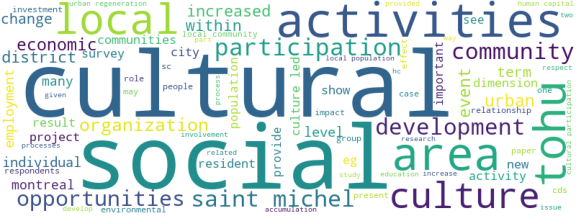| Id | 144 | |
| Author | Blessi, G.T., ; Tremblay , D., G.; Sandri, M., ; Pilati, T., | |
| Title | New trajectories in urban regeneration processes: Cultural capital as source of human and social capital accumulation – Evidence from the case of Tohu in Montreal | |
| Reference | Blessi, G.T., Tremblay, D.G., Sandri, M., Pilati, T. (2012). New trajectories in urban regeneration processes: Cultural capital as source of human and social capital accumulation – Evidence from the case of Tohu in Montreal. Cities, 29(6), 397‑407. |
|
| Link to article | https://doi.org/10.1016/j.cities.2011.12.001 |
|
| Abstract | Throughout the late 20th and early 21st Centuries, culture has gained increasing importance in strategies designed to deal with new trajectories of urban areas. Post-industrial cities seek to revive former industrial, contaminated and waterfront sites and their city centers, as they are aiming to establish themselves in the new arena of the global market place. This paper looks at the relationships between investments in cultural resources/activities and urban regeneration processes, and in this respect, how culture can be considered a determinant to the accumulation of human and social capital. It examines the transformation of the Saint Michel district located in metropolitan Montreal. The Saint Michel area is experiencing a radical change in its social, economic and environmental profile due to its transition from the industrial led development model to the postindustrial model in which investments in cultural and creative activities/industries particularly the headquarters of Cirque du Soleil and TOHU – La Cité des Arts du Cirque – are supplying new opportunities for the local area in a metropolitan dimension. What impacts does such clustering have on the social and human capital of the vast majority of the populations that live within this area? Based on a theoretical review and empirical investigation, the paper presents some clarification of the role of cultural investment in the definition of an emerging sustainable social scheme within the community to promote the development of local social and human capital. We know that cultural habits do not change quickly, and our research shows that organizations need to be proactive and seek very actively the participation of the local community if they want to see changes. Our case study highlights the fact that itis important to invest actively in mobilization, local information and promotion and to do so with the cooperation of local community organizations to attain some form of bonding with the local population, have the positive effects expected in terms of involvement in the community and act as a lever for local socioeconomic development |
|
| Keywords | Urban areas; Urban regeneration; Cultural capital; Human capital; Social capital |
Wordcloud:



